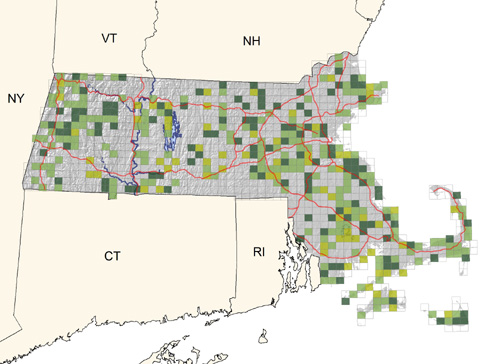Breeding Bird Atlases (BBA)
Find a Bird - BBA1
Breeding Bird Atlas 1 Species Accounts
American Woodcock
Scolopax minor
Egg Dates
March 20 to June 15
Number of Broods
one; may re-lay if first attempt fails.

At the turn of the century, the American Woodcock was a vanishing bird, principally due to unregulated spring shooting and wetland drainage. The enactment of protective legislation resulted in a resurgence of woodcock populations by the 1920s. However, woodcock numbers in the Northeast are once again on the decline because of loss of habitat and lowered survival rates resulting from development and succession of abandoned-field and alder habitats. Annual ground surveys of singing males were instituted in 1953 as a measure of breeding trends. During the Atlas period, woodcocks were "confirmed" in all sections of the state.
Woodcocks are exceptionally early migrants, often arriving in the Northeast when there is still snow on the ground. In most years, they reach central Massachusetts by mid-March, but February records occur frequently. Woodcocks habitually return to the same breeding grounds each year, as demonstrated by research in Quabbin, where 80 percent of 84 banded males returned to within 1 mile of the initial capture site.
Typical woodcock singing grounds are old fields, pastures, or boggy areas. Daytime habitat includes alder swales, patches of second-growth hardwoods, and mixed forest with rich, moist soil. Night roosting occurs in fields and forest openings. On the wintering grounds, woodcocks concentrate in bottomlands, cleared croplands, and pastures.
The evocative courtship activities of the male woodcock consist of an aerial display and flight song, preceded and followed by location calls and occasional strutting on the ground. The singing area is defended aggressively against other males. The auditory element of the display flight is both mechanical and vocal, with a twittering, whistling sound generated by air currents rushing through three notched outer primaries, combined with vocalizations consisting of a series of high-pitched chirps. Ground calls consist of a nasal, buzzy peent preceded by a soft took-oo. Females may peent occasionally. Male woodcocks may mate with several hens, but they take no part in incubation or rearing the young.
Woodcocks nest in a slight depression on the ground in abandoned fields, plantations, brushlands, or open mixed forest. Thirty Massachusetts nests were found within 150 feet of a singing ground. Clutch size is normally four but may range from two to five, and incubation lasts about 21 days. The egg-laying peak in Massachusetts is in mid- to late April, with 52 percent of the nests hatching before May 7 and 69 percent hatching by May 15. Nesting success ranges from 42 percent in Massachusetts to 62 percent in Maine. The young are precocial, although the hen broods them frequently for the first several days and for lesser periods until their primary feathers develop. Weather extremes commonly affect breeding woodcocks by chilling chicks and by depressing earthworm availability. As they mature, the juveniles progressively wander farther from the hen, and most broods break up in six to eight weeks after hatching.
Migration begins in Canada in early September, with most migrants passing through Massachusetts in mid-October. Individuals may linger in southeastern sections of the state until mid-November, rarely later. Local birds winter on the Atlantic and Gulf coastal plains from the Carolinas to Texas.
Map Legend and Data Summary
Atlas 1 data collected from 1975-1979


Note: uncommon in wet thickets and moist woodland edges throughout state
James E. Cardoza



